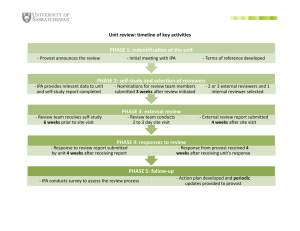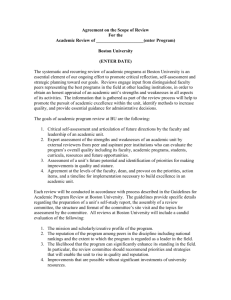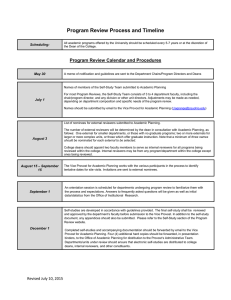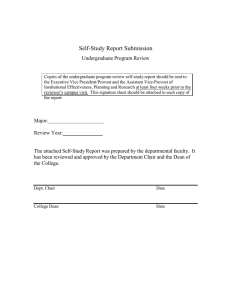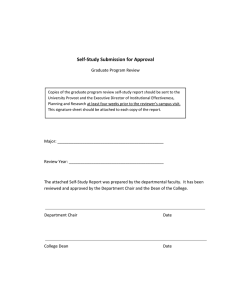Michigan Technological University Procedure for Periodic Review of Academic Degree Programs
advertisement
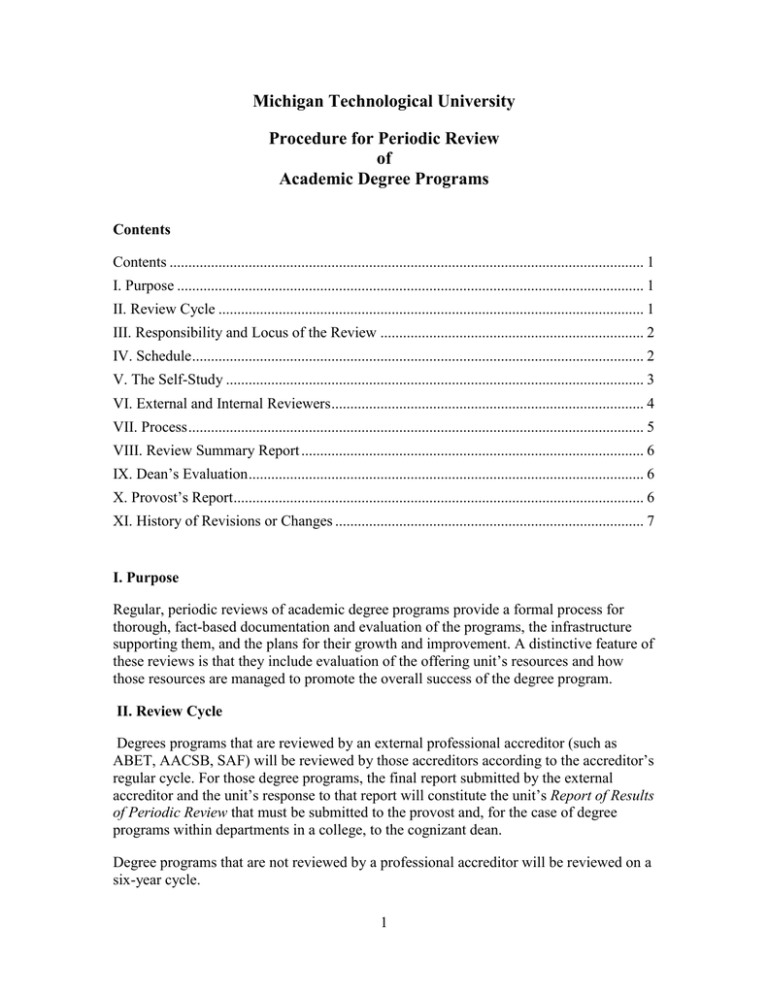
Michigan Technological University Procedure for Periodic Review of Academic Degree Programs Contents Contents .............................................................................................................................. 1 I. Purpose ............................................................................................................................ 1 II. Review Cycle ................................................................................................................. 1 III. Responsibility and Locus of the Review ...................................................................... 2 IV. Schedule ........................................................................................................................ 2 V. The Self-Study ............................................................................................................... 3 VI. External and Internal Reviewers ................................................................................... 4 VII. Process ......................................................................................................................... 5 VIII. Review Summary Report ........................................................................................... 6 IX. Dean’s Evaluation ......................................................................................................... 6 X. Provost’s Report ............................................................................................................. 6 XI. History of Revisions or Changes .................................................................................. 7 I. Purpose Regular, periodic reviews of academic degree programs provide a formal process for thorough, fact-based documentation and evaluation of the programs, the infrastructure supporting them, and the plans for their growth and improvement. A distinctive feature of these reviews is that they include evaluation of the offering unit’s resources and how those resources are managed to promote the overall success of the degree program. II. Review Cycle Degrees programs that are reviewed by an external professional accreditor (such as ABET, AACSB, SAF) will be reviewed by those accreditors according to the accreditor’s regular cycle. For those degree programs, the final report submitted by the external accreditor and the unit’s response to that report will constitute the unit’s Report of Results of Periodic Review that must be submitted to the provost and, for the case of degree programs within departments in a college, to the cognizant dean. Degree programs that are not reviewed by a professional accreditor will be reviewed on a six-year cycle. 1 It is recommended that the undergraduate and graduate programs within a given department or school be addressed as part of a single review process whenever possible. If the undergraduate programs in a department/school are reviewed by an external professional accreditor that does not review graduate programs, it is recommended that the graduate programs be reviewed as soon as possible following the completion of the Report of Results of Periodic Review for the undergraduate programs. Beyond the six-year cycle or professional accreditation cycle requirement, however, the scheduling of degree program reviews is at the discretion of the department/school that offers the degree program. The plan for upcoming reviews shall be reviewed annually by the academic deans and provost to accommodate changes in accrediting timelines, schedules, or cycles. III. Responsibility and Locus of the Review Departments/schools are responsible for ensuring that all degree program reviews are conducted at the specified times. Departments and schools are also responsible for preparation and submission of all documentation associated with the review process. Degree programs reviewed within the context of professional accreditation follow the accreditors’ review guidelines. Reviews of other degree programs are initiated by the provost through a memo to the cognizant dean(s). Deans will work with their school, or with the cognizant department chair(s) (in the case of reviews of departments within a college), to establish a timeline, identify specific expectations for the review, and identify external and internal reviewers. IV. Schedule Degree programs reviewed by a professional accreditor will follow the accreditor’s schedule for selection of reviewers, submission of self-study documents, on-site reviews, etc. Degree programs (including graduate programs) that are not reviewed by an external professional accreditor will follow the schedule outlined here: i. Departments/schools with a degree program to be reviewed in the upcoming academic year will be notified during the fall semester preceding the review year. ii. During the academic year preceding the review, departments and schools will prepare their self-study documents. iii. The self-study documents must be submitted to the provost and the cognizant dean (for departmental programs within colleges) by the end of the fall semester of the review year. 2 iv. The provost’s office will provide the self-study documents to the external and internal reviewers by the second week of the spring semester. v. The campus visit by external reviewers will be completed by the eighth week of the spring semester of the review year, and reviewers’ reports will be due in the provost’s office by the end of the eleventh week of spring semester. Copies of the reports will be provided by the provost to the cognizant dean and department chair (for departmental programs within a college). vi. The school dean and provost (for degree programs within schools) or the department chair and college dean (for departmental programs within a college) will meet with the faculty of the school/department to discuss the reviewers’ reports before the end of spring semester. vii. The school or department will provide the provost and the cognizant dean (in the case of reviews of departmental programs within a college) its Report of Results of Periodic Review (described below) by October 15 during the academic year following the review. Each report should be preceded by a cover letter from the dean of the school or chair of the department that summarizes the review’s process and outcomes. viii. The provost reports the findings of the degree program review to the Board of Trustees in a timely fashion. V. The Self-Study Each department or school with a degree program up for review undergoes a self-study to assess the strengths and limitations of the degree program within the context of the offering unit and its resources. The self-study should provide a comprehensive overview of the degree program that can guide the review team. For degree programs reviewed by professional accreditors, departments/schools conduct the associated self-study following the accreditors’ guidelines. For all other degree programs, the departments/schools should first consider whether a single review team can review all degree programs within the unit (department or school) or if the diversity of degree programs calls for multiple review teams. If multiple review teams are needed/used, then a self-study document for each review team must be prepared. If a single review team is used for multiple degree programs, then it is left to the discretion of the department/school as to whether a single self-study document is prepared or if multiple self-study documents (e.g., one for undergraduate programs and one for graduate programs, OR one for each undergraduate program and one for each graduate program, OR some combination thereof) are warranted. The principal author(s) of a self-study document may be the department chair/school dean or a committee. The final document(s) should represent a departmental consensus whenever possible. i. Data: The self-study shall contain, but not be limited to, the following information and analyses: Departmental mission and vision statements and degree program learning goals for each program covered by the study 3 ii. iii. Quantitative data: Basic information that should include categories such as faculty (number, ranks, demographics) and staff (roles), with details on how advising is handled; facilities; budgets; students (number, degree programs, demographics); retention and degree completion; placement after graduation; and scholarship (publications, presentations, funding). Institutional Analysis will provide basic data using a uniform template. The department may provide additional data as needed. Results of assessment of student learning outcomes, analyses of results, and evidence that results are used for continuous improvement. Results of surveys of graduates and their employers, as appropriate Recent initiatives and their effects Goals for the future The self-study shall conclude with responses to the following questions: In what ways does the program support both the University’s and your college’s/school’s mission and vision statements? In what ways does the academic program align with the University’s strategic plan? In what ways is the program or the students, faculty, and staff associated with the program contributing to an increase in awareness of the quality of Michigan Tech’s educational offerings and research capabilities within the state, nationally, and internationally? How does the research and scholarly activities of faculty (and potentially staff) enhance the learning experiences for students in the program? What are the principles that guide decisions regarding the allocation of resources for the program? Additional questions: Additional questions may be added by the cognizant deans (for reviews of departmental programs within colleges), the dean of the Graduate School (for reviews of graduate programs), or the provost to gain information from reviewers that will support the University’s ongoing continual improvement processes. Appendices: Additional information may be presented in appendices that are referred to in the main body of the self-study document. VI. External and Internal Reviewers i. Composition of review team: For degree programs reviewed by professional accreditors, departments and schools will follow the accreditors’ guidelines for the number and selection of external reviewers. 4 For review of all other degree programs, departments and schools will involve a minimum of two external and one internal reviewers. ii. iii. iv. Qualifications of reviewers: External reviewers should be senior academic faculty members, department chairs, deans, or individuals of similar professional stature. External reviewers should have experience with both undergraduate and graduate education in the disciplinary areas represented by the programs under review. Internal reviewers must be tenured members of the graduate faculty at Michigan Tech and may not be affiliated with the unit (department or school) offering the degree program under review. For the review of nondepartmental or interdisciplinary programs, internal reviewers must not be affiliated with those programs. Selection of reviewers: The unit (department/school) offering the degree program being reviewed will recommend a slate of at least five potential external and at least five potential internal reviewers to the cognizant dean/provost. The cognizant dean (for departments) or the provost (for schools) will invite the reviewers to serve. Selected reviewers must submit a copy of their curriculum vitae to the dean of the college (for departmental program reviews) or to the provost (for school program reviews) prior to conducting the review. Incentives: The reviewers are to review the self-study document prior to visiting the campus and conducting their on-site review. Travel expenses for external reviewers will be paid in accordance with university travel policy and an appropriate honorarium will be provided to external reviewers following completion of the review and submission of a report on findings. Internal reviewers will be provided with an appropriate honorarium. Participation of internal reviewers is intended to improve University-wide appreciation of the aspirations of each academic unit. Internal reviewers will also be able to assist external reviewers in accessing additional information, which will improve the efficiency of the review process. VII. Process For degree programs reviewed by profession accreditors, departments and schools should adhere to the accreditors’ guidelines for conducting reviews if those guidelines deviate from the process outlined below. The reviewers will read the self-study prior to their on-campus visit and review. 5 Each review team visit will include meetings with the chair/dean, the dean of the Graduate School (if graduate programs are involved), faculty, staff, and students. Each visit should include a visit to relevant facilities, including research and teaching laboratories, classrooms, and offices. At the conclusion of their visit, the reviewers will prepare a report addressed to the chair or dean of the unit offering the program under review. A standard set of questions, which will be addressed in every review, will guide development of the reviewers’ report. These questions will be reviewed on an annual basis by the deans, associate provost(s), and provost and updated as necessary. School deans and/or department chairs may supplement the standard questions with additional queries, and the reviewers will be encouraged to provide additional information that is not specifically requested (e.g., recommendations) in order to provide useful feedback to the unit offering the reviewed program. Reviewer reports will be delivered by the reviewers to the provost’s office by the end of the eleventh week of spring semester. Copies of the reports will be provided by the provost to the cognizant dean and department chair (for departmental programs within a college). VIII. Review Summary Report Following receipt of the reviewers’ report, the department will prepare for the dean, or the school for the provost, a report (Report of Results of Periodic Review) that contains the following sections: Section I - a one-page executive summary Section II - the reviewers’ report Section III - a listing of the principal observations, comments, and recommendations made by the reviewers in their report Section IV - the department’s/school’s response to the reviewers’ report Section V - an action plan The department’s/school’s response should bring together everything that has been learned through the review and outline plans for the future. The action plan should include a timeline for completion of specific milestones. The action plan should specifically outline a strategy for aligning and/or reallocating resources (if necessary) to support completion of milestones. IX. Dean’s Evaluation The cognizant dean will provide the provost with a copy of the unit’s Report of Results of Periodic Review. Each report should be preceded by a cover letter from the dean of the school or college that contains a summary of the dean’s analysis of the review’s process and outcomes. X. Provost’s Report The provost will communicate the findings of the degree program review to the Board of Trustees in a timely fashion. 6 XI. History of Revisions or Changes 08/25/2004 01/19/2016 03/01/2016 04/05/2016 Initial Procedures Adopted Revised Procedures open for Review and Comment Revised Based on Comments Revised Based on Comments 7
